Use the material in the project of JICA Technical Cooperation in Angola
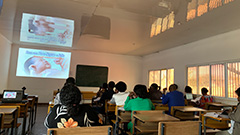
Screening the material in the training. The training was performed 7 times over 5 days, with a total of 170 trainees viewing the material.
JICA has been implementing the "Project for Improving the Quality of Maternal Health Services at Primary Health Care Facilities" in Angola since September 2023, focusing on maternal and child health care.
We are working on this project with the aim of increasing the rate of institutional births in the target provinces. As part of the activities, the training to promote respectful maternal care for pregnant and delivering women was performed from July to September 2024.
When we prepared to start the training about respectful maternal care for pregnant and delivering women, we considered that the JICA-Net multimedia-based learning material, “For Safe and Happy Childbirth: JICA's Approach to Humanized Maternity Care” (YouTube, external link)
, was suitable to let trainees know JICA’s “Humanized Maternity Care” project.
Moreover, although the number of materials in Portuguese is limited, this material was created in the Portuguese and could therefore be used in the training.
What is the “Humanized Maternity Care”?
Childbirth is a physiological and cultural process and 85% of births follow a natural course.
midwifery care means maximizing the innate capacities of women and babies, respecting them, and providing them a secure and safe pregnancy, delivery, and postnatal period.
To date, JICA has brought such humanized maternity care projects focused on improving midwifery care in eight countries. The improvement of midwifery capabilities through the project has led to a reduction in unnecessary medical intervention and an increase in care that encourages evidence-based deliveries. It has also contributed to reductions in maternal and neonatal mortality.
The material explains the importance of midwifery capability and care, and then introduces what the “Humanized Maternity Care” is through JICA’s project in Brazil and Cambodia.
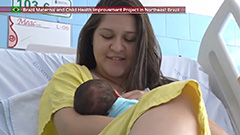
The material introduces what the “Humanized Maternity Care” is through JICA’s project in Brazil and Cambodia.
The training using the material in Angola
To date, the training for 5 days was performed seven times. A total of 170 trainees participated, including staff in charge of maternal child health of the National Directorate of Public Health, Ministry of Health, Provincial and Municipal Health Office, and medical workers of target hospitals and health centers.
Sharing the concept of Humanized Maternity Care (Strengthening respectful maternal care for pregnant and delivering women)
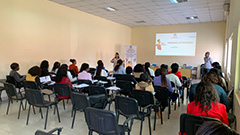
The training of Maternity Care.
To improve a place for delivery as a “humanized” situation where women’s dignity and independence are respected. JICA aims to achieve this through “Humanized Maternity Care” and “The humanization of childbirth and delivery”.
“Humanization” in Angola emphasizes “enhancing physical care” for patients such as the preparation of medical equipment, and free treatment and checkup system.
However, in addition to this, “psychological humanization” is more important, which receives patients warmly and provides them with respectful maternal care.
However, there are many cases where not even adequate physical care is provided, not to mention the mental care given to patients which is non-existent.
Humanization is also an important concept for not only patients but also medical workers.
Working in safe and supportive environment, getting a stable income and receiving training to improve their skills are part of humanization.
By providing care, the patient will be grateful and a relationship of trust between medical workers and patients will be built. It will empower medical workers and they will provide a better care for patients. Thus, a good cycle will occur.
Based on that interactive humanization, “Humanized Maternity Care / The humanization of childbirth” will be realized.
Through this material, we were able to convey the messages of those who have been involved in JICA’s projects related to the humanization of childbirth.
To identify issues and recognize the ideal delivery environment
There is a big gap between the ideal and the reality of “Humanized Maternity Care” in Angla. Especially in rural areas, A woman gives birth to an average of six children, many of them in large provincial and city hospitals, despite the shortage of medical workers for that reason, patients cannot receive adequate care. Specifically, the disrespect of women’s privacy has been pointed out. Currently, many hospitals do not have curtains and partitions between beds, an environment where pregnant women cannot give birth with peace of mind.
The trainees who watched the material gave practical opinions such as “In reality, it is difficult to realize an ideal care because the number of deliveries is too many.” and “There is no private space where a husband can accompany in health care facilities.”.
However, all trainees felt that the maternity environment and care shown in the video is “ideal”.
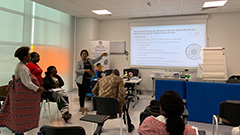
Role-playing the Humanized Maternity Care.
Discussion toward a concrete suggestion
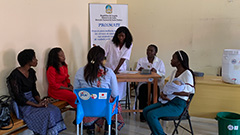
Role-playing the discharge guidance including family members.
There were some concrete suggestions to approach the ideal: “Improving delivery rooms in small-scale health care facilities so childbirth is not concentrated on large-scale hospitals, and enabling women who want to deliver there.” and “Preparing equipment and medicines, performing a training for facility managers to improve management.”
These suggestions would avoid the concentration of childbirth burden on large-scale hospitals and allow Humanized Maternity Care.
Raising an awareness leads to change in actions
Although some trainees thought that “Preparing equipment is the most important for humanization”, they changed their perception through five days of training. Specifically, they became aware that it was important to give respectful care to women even in limited circumstances finding suitable approaches to improve the environment and increasing the satisfaction among women.
After the training, some medical workers began the effort, for example, they allowed relatives with whom the women wanted to stay into the delivery room, received patients warmly, supporting them, encouraging them, and providing a massage when women needed it. A woman who received good care could share her experience with her community and, as a result, a good reputation could spread. This will lead to an improvement in the birth rate in hospitals, which is the aim of the project.
In this way, although “Humanized Maternity Care / The humanization of childbirth” in Angola has practical challenges, concrete actions toward improvement and changes in awareness are advancing through the project’s activities. Based on this experience, we would like to use the material in various situations.
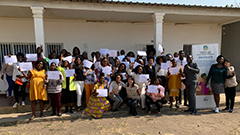
A group photo after the training of maternity care in Huíla Province, holding graduation certificate.
JICA Human Development Department
KUROBE Kanjin
*The Material(s) mainly applied
For Safe and Happy Childbirth: JICA's Approach to Humanized Maternity Care
This material explains JICA's Humanized Maternity Care approach in the field of maternal and child health, through the projects in Brazil and Cambodia. The material was created to publicize and disseminate the Humanized Maternity Care Approach which was started in Brazil in 1996. Until now, JICA has brought such Humanized Maternity Care projects, which focus on improving midwifery care, to 8 countries. Suggested uses for this material include university lectures, symposiums, seminars and training sessions in Japan and abroad. Besides, this program is good for the general public to think about happy childbirth.




scroll